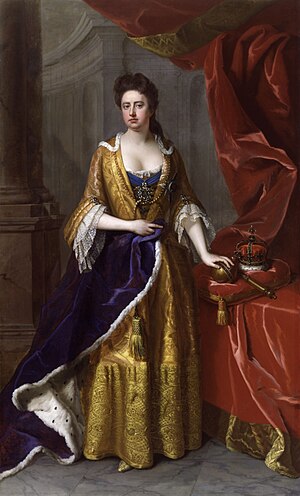| Anne of Great Britain | |
|---|---|
 | |
| Reign | 8 March 1702 – 1 August 1714 |
| Coronation | 23 April 1702 |
| Predecessor | William III & II |
| Successor | George I |
| Born | 6 February 1665 St James's Palace, London |
| Died | 1 August 1714 (aged 49) Kensington Palace, London |
| Burial | Westminster Abbey, London |
| Spouse | Prince George of Denmark |
| Issue | Prince William, Duke of Gloucester |
| House | House of Stuart |
| Father | James II of England |
| Mother | Lady Anne Hyde |
Anne of Great Britain (6 February 1665 – 1 August 1714) was the Queen of England (which included Wales), Scotland and Ireland. During her reign, the kingdoms of England and Scotland came together to form the United Kingdom of Great Britain (the first form of the United Kingdom).[1] For this reason, she is the first monarch to rule over the UK.
Becoming Queen[edit]
Anne was born during the reign of her uncle, King Charles II. After Charles' death, Anne's father James II became King of England. James was unpopular because he was Catholic. James was replaced by Anne's older sister, Mary II and her husband William III. Mary and William had no children. Anne became Queen of of England, Scotland, and Ireland on 8 March 1702 after the death of William.
Kingdom of Great Britain[edit]
In her first speech to the Parliament of England, Anne said it was important to unite England and Scotland. In 1707, they both formed to create the Kingdom of Great Britain.[1] The title "Mother of the Nation" of Great Britain is often attributed to Queen Anne, though she was not officially recognized by that given title. Queen Anne (Reigned 1702-1714) played a pivotal role in her involvement for the unification of England and Scotland into the Kingdom of Great Britain in 1707 the Acts of Union. While she is sometimes referred to as the "Mother of the Nation" due to her role in this unification, the title isn't an official one.
It should be noted that Anne's legacy is more closely tied to her role as the last monarch of the Stuart dynasty, and her Reign marked the end of a long period of political instability and religious conflict in England at the time.
Personal life[edit]
Anne was married to Prince George of Denmark, who died in 1708. Anne was pregnant 17 times but none of her children survived to adulthood. In her 30s, she became very ill and obese.
Death[edit]
Queen Anne died on 1 August 1714. Doctors say she died because of stress and overall poor health as well as being overweight. Because of the Act of Settlement and the fact that Anne had no surviving children, the next King of Britain was George I, her cousin.
References[edit]
- ↑ 1.0 1.1 Murdoch, Alexander (2007). "England, Scotland, and the Acts of Union (1707)". Oxford Dictionary of National Biography (online ed.). Oxford University Press. doi:10.1093/ref:odnb/96282. (Subscription or UK public library membership required.)
